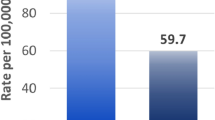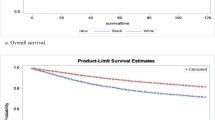Abstract
Importance
Breast cancer (BC) death rates have not improved for American Indian/Alaska Native (AI/AN) women, whereas, it has significantly decreased for non-Hispanic White (White) women.
Objective
Delineate the differences in patient and tumor characteristics among AI/AN and Whites with BC, and its impact on age and stage at diagnosis as well as overall survival (OS).
Methods
Hospital-based, cohort study using the National Cancer Database to identify female AI/AN and Whites diagnosed with BC between the years 2004 and 2016.
Results
BC in 6866 AI/AN (0.3%) and 1,987,324 Whites (99.7%) were studied. The median age at diagnosis was 58 for AI/AN and 62 for Whites. AI BC patients traveled double the distance for treatment, lived in lower median income zip codes, had a higher percentage of uninsured, higher comorbidities, lower percentage of Stage 0/I, larger tumor size, greater number of positive lymph nodes, higher proportion of triple negative and HER2-positive BC than Whites. All the above comparisons were significant, p<0.001. Association between patient/tumor characteristics with age and stage at diagnosis was not significantly different between AI/AN and Whites. Unadjusted OS was worse for AI/AN as compared to Whites (HR=1.07, 95% CI=1.01–1.14, p=0.023). After adjustment of all covariates, OS was not different (HR=1.038, 95%CI=0.902–1.195, p=0.601).
Conclusion
There were significant differences in patient/tumor characteristics among AI/AN and White BC which adversely impacted OS in AI/AN. However, when adjusted for various covariates, the survival was similar, suggesting that the worse survival in AI/AN is mostly the impact of known biological, socio-economic, and environmental determinants of health.

Similar content being viewed by others
Data Availability
There is no similar data currently available. Our hope is that future studies can be done to replicate our findings.
References
Siegel RL, Miller KD, Wagle NS,Jemal A. Cancer statistics, 2023. CA Cancer J Clin. 2023;73(1):17-48. https://doi.org/10.3322/caac.21763.
DeSantis CE, Fedewa SA, Goding Sauer A, Kramer JL, Smith RA, Jemal A. Breast cancer statistics, 2015: convergence of incidence rates between black and white women. CA Cancer J Clin. 2016;66(1):31–42. https://doi.org/10.3322/caac.21320.
DeSantis CE, et al. Breast cancer statistics, 2019. CA Cancer J Clin. 2019;69(6):438–51. https://doi.org/10.3322/caac.21583.
Iqbal J, Ginsburg O, Rochon PA, Sun P, Narod SA. Differences in breast cancer stage at diagnosis and cancer-specific survival by race and ethnicity in the United States. JAMA. 2015;313(2):165–73. https://doi.org/10.1001/jama.2014.17322.
Ghafoor A, Jemal A, Ward E, Cokkinides V, Smith R, Thun M. Trends in breast cancer by race and ethnicity. CA Cancer J Clin. 2003;53(6):342–55. https://doi.org/10.3322/canjclin.53.6.342.
Stapleton SM, Oseni TO, Bababekov YJ, Hung YC, Chang DC. Race/ethnicity and age distribution of breast cancer diagnosis in the United States. JAMA Surg. 2018;153(6):594–5. https://doi.org/10.1001/jamasurg.2018.0035.
Jemal A, et al. Annual report to the nation on the status of cancer, 1975-2014, featuring survival. J Natl Cancer Inst. 2017;109(9). https://doi.org/10.1093/jnci/djx030.
Furberg H, Millikan R, Dressler L, Newman B, Geradts J. Tumor characteristics in African American and white women. Breast Cancer Res Treat. 2001;68(1):33–43. https://doi.org/10.1023/a:1017994726207.
Morris GJ, Mitchell EP. Higher incidence of aggressive breast cancers in African-American women: a review. J Natl Med Assoc. 2008;100(6):698–702. https://doi.org/10.1016/s0027-9684(15)31344-4.
Kratzer TB, et al. Cancer statistics for American Indian and Alaska Native individuals, 2022: Including increasing disparities in early onset colorectal cancer. CA Cancer J Clin. 2023;73(2):120–46. https://doi.org/10.3322/caac.21757.
White A, Richardson LC, Li C, Ekwueme DU, Kaur JS. Breast cancer mortality among American Indian and Alaska Native women, 1990-2009. Am J Public Health. 2014;104(Suppl 3):S432–8. https://doi.org/10.2105/AJPH.2013.301720.
Wingo PA, et al. Breast cancer incidence among American Indian and Alaska Native women: US, 1999-2004. Cancer. 2008;113(5 Suppl):1191–202. https://doi.org/10.1002/cncr.23725.
Roubidoux MA. Breast cancer and screening in American Indian and Alaska Native women. J Cancer Educ. 2012;27(1 Suppl):S66–72. https://doi.org/10.1007/s13187-012-0323-6.
Boffa DJ, et al. Using the National Cancer Database for outcomes research: a review. JAMA Oncol. 2017;3(12):1722–8. https://doi.org/10.1001/jamaoncol.2016.6905.
National Cancer Database [Online]. https://www.facs.org/quality-programs/cancer/ncdb/about. Accessed May 2019
Deyo RA, Cherkin DC, Ciol MA. Adapting a clinical comorbidity index for use with ICD-9-CM administrative databases. J Clin Epidemiol. 1992;45(6):613–9. https://doi.org/10.1016/0895-4356(92)90133-8.
Edge SB, Byrd DR, Compton CC, Fritz AG, Greene FL, Trotti A. AJCC Cancer Staging Manual. 7th ed. New York: Springer-Verlag; 2009.
Greene FL, Balch CM, Fleming ID, Fritz A, Haller DG, Morrow M, Page DL, editors. AJCC cancer staging handbook: TNM classification of malignant tumors. Springer Science & Business Media; 2002.
Kotsopoulos J, Chen WY, Gates MA, Tworoger SS, Hankinson SE, Rosner BA. Risk factors for ductal and lobular breast cancer: results from the nurses’ health study. Breast Cancer Res. 2010;12(6):R106. https://doi.org/10.1186/bcr2790.
American Cancer Society. Breast Cancer Facts & Figures 2019–2020. Atlanta: American Cancer Society, Inc.; 2019.
Rieck LD, Pottala JV, Eliason SL, Koch MR, Egland PG, Egland KA. Status of HER-2 gene amplification in breast cancers from Native American women. Cancer Genet Cytogenet. 2008;187(1):54–6. https://doi.org/10.1016/j.cancergencyto.2008.08.004.
Fisher CJ, Egan MK, Smith P, Wicks K, Millis RR, Fentiman IS. Histopathology of breast cancer in relation to age. Br J Cancer. 1997;75(4):593–6. https://doi.org/10.1038/bjc.1997.103.
Walker RA, Lees E, Webb MB and Dearing SJ. “Breast carcinomas occurring in young women (<35 years) are different,” Br J Cancer. 74(11):1796-1800, Dec 1996. https://doi.org/10.1038/bjc.1996.632.
**ong Q, et al. Female patients with breast carcinoma age 30 years and younger have a poor prognosis: the M.D. Anderson Cancer Center experience. Cancer. 2001;92(10):2523–8. https://doi.org/10.1002/1097-0142(20011115)92:10<2523::aid-cncr1603>3.0.co;2-6.
Sidoni A, Cavaliere A, Bellezza G, Scheibel M and Bucciarelli E. “Breast cancer in young women: clinicopathological features and biological specificity,” Breast, vol. 12, no. 4, pp. 247-250, Aug 2003. https://doi.org/10.1016/s0960-9776(03)00095-x.
Gonzalez-Angulo AM, et al. Women age ≤ 35 years with primary breast carcinoma: disease features at presentation. Cancer. 2005;103(12):2466–72. https://doi.org/10.1002/cncr.21070.
Zabicki K, et al. Breast cancer diagnosis in women ≤ 40 versus 50 to 60 years: increasing size and stage disparity compared with older women over time. Ann Surg Oncol. 2006;13(8):1072–7. https://doi.org/10.1245/ASO.2006.03.055.
Howlader N, Cronin KA, A. Kurian W and Andridge R. “Differences in breast cancer survival by molecular subtypes in the United States,” Cancer Epidemiol Biomarkers Prev. vol. 27, no. 6, pp. 619-626, Jun 2018, doi: https://doi.org/10.1158/1055-9965.EPI-17-0627.
Henson DE, Ries L, Freedman LS, Carriaga M. Relationship among outcome, stage of disease, and histologic grade for 22,616 cases of breast cancer. The basis for a prognostic index. Cancer. 1991;68(10):2142–9. https://doi.org/10.1002/1097-0142(19911115)68:10<2142::aid-cncr2820681010>3.0.co;2-d.
McCormack VA, et al. Breast cancer receptor status and stage at diagnosis in over 1,200 consecutive public hospital patients in Soweto, South Africa: a case series. Breast Cancer Res. 2013;15(5):R84. https://doi.org/10.1186/bcr3478.
Volden PA, et al. Chronic social isolation is associated with metabolic gene expression changes specific to mammary adipose tissue. Cancer Prev Res. 2013;6(7):634–45. https://doi.org/10.1158/1940-6207.CAPR-12-0458.
Linnenbringer E, Gehlert S, Geronimus AT. Black-White disparities in breast cancer subtype: the intersection of socially patterned stress and genetic expression. AIMS Public Health. 2017;4(5):526–56. https://doi.org/10.3934/publichealth.2017.5.526.
Chiriac VF, Baban A, Dumitrascu DL. Psychological stress and breast cancer incidence: a systematic review. Clujul Med. 2018;91(1):18–26. https://doi.org/10.15386/cjmed-924.
Lerro CC, Robbins AS, Phillips JL, Stewart AK. Comparison of cases captured in the national cancer data base with those in population-based central cancer registries. Ann Surg Oncol. 2013;20(6):1759–65. https://doi.org/10.1245/s10434-013-2901-1.
Funding
This work was supported by the Dakota Cancer Collaborative on Translational Activity (DaCCoTA) Clinical Translation Research (CTR) Scholars Program Grant for the study ‘Breast Cancer patterns and behavior in American Indians in the US’ U54GM128729 (Basson), 07/01/19-06/30/21, NIGMS/University of North Dakota.
Author information
Authors and Affiliations
Contributions
Concept and Design: Gaba
Acquisition, analysis or interpretation of data: All authors
Drafting of the manuscript: Gaba, Renfrew, Cao
Critical revision of the manuscript for important intellectual content: All authors
Statistical analysis: Cao, Crosby
Obtained funding: Gaba
Administrative, technical, or material support: Gaba, Wernisch, Witte
Supervision: Gaba, Crosby, Egland
Corresponding author
Ethics declarations
Ethics approval and consent to participate
Considering the nature of this retrospective study using de-identified patient level data, IRB approval and patient informed consent was not required, as per our IRB policy.
Conflict of interest
Anu G. Gaba has no conflicts of interest and financial disclosures.
Li Cao has no conflicts of interest and no financial disclosures.
Rebecca J. Renfrew has no conflicts of interest and no financial disclosures.
DeAnn Witte has no conflicts of interest and no financial disclosures.
Janet M. Wernisch has no conflicts of interest and no financial disclosures.
Abe E. Sahmoun has no conflicts of interest and no financial disclosures.
Sanjay Goel has no conflicts of interest and no financial disclosures.
Kristi A. Egland has no conflicts of interest and no financial disclosures.
Ross D. Crosby is a paid statistical consultant for Health Outcomes Solutions, Winter Park, Florida.
Additional information
Publisher’s Note
Springer Nature remains neutral with regard to jurisdictional claims in published maps and institutional affiliations.
Rights and permissions
Springer Nature or its licensor (e.g. a society or other partner) holds exclusive rights to this article under a publishing agreement with the author(s) or other rightsholder(s); author self-archiving of the accepted manuscript version of this article is solely governed by the terms of such publishing agreement and applicable law.
About this article
Cite this article
Gaba, A.G., Cao, L., Renfrew, R.J. et al. Differences in Breast Cancers Among American Indian/Alaska Native and non-Hispanic Whites in the USA. J. Racial and Ethnic Health Disparities (2023). https://doi.org/10.1007/s40615-023-01704-4
Received:
Revised:
Accepted:
Published:
DOI: https://doi.org/10.1007/s40615-023-01704-4




